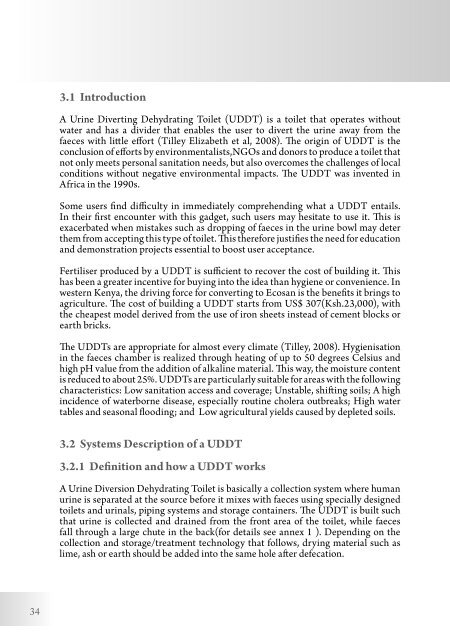Technical Guide to EcoSan Promotion
Technical Guide to EcoSan Promotion
Technical Guide to EcoSan Promotion
Create successful ePaper yourself
Turn your PDF publications into a flip-book with our unique Google optimized e-Paper software.
3.1 Introduction<br />
A Urine Diverting Dehydrating Toilet (UDDT) is a <strong>to</strong>ilet that operates without<br />
water and has a divider that enables the user <strong>to</strong> divert the urine away from the<br />
faeces with little effort (Tilley Elizabeth et al, 2008). The origin of UDDT is the<br />
conclusion of efforts by environmentalists,NGOs and donors <strong>to</strong> produce a <strong>to</strong>ilet that<br />
not only meets personal sanitation needs, but also overcomes the challenges of local<br />
conditions without negative environmental impacts. The UDDT was invented in<br />
Africa in the 1990s.<br />
Some users find difficulty in immediately comprehending what a UDDT entails.<br />
In their first encounter with this gadget, such users may hesitate <strong>to</strong> use it. This is<br />
exacerbated when mistakes such as dropping of faeces in the urine bowl may deter<br />
them from accepting this type of <strong>to</strong>ilet. This therefore justifies the need for education<br />
and demonstration projects essential <strong>to</strong> boost user acceptance.<br />
Fertiliser produced by a UDDT is sufficient <strong>to</strong> recover the cost of building it. This<br />
has been a greater incentive for buying in<strong>to</strong> the idea than hygiene or convenience. In<br />
western Kenya, the driving force for converting <strong>to</strong> Ecosan is the benefits it brings <strong>to</strong><br />
agriculture. The cost of building a UDDT starts from US$ 307(Ksh.23,000), with<br />
the cheapest model derived from the use of iron sheets instead of cement blocks or<br />
earth bricks.<br />
The UDDTs are appropriate for almost every climate (Tilley, 2008). Hygienisation<br />
in the faeces chamber is realized through heating of up <strong>to</strong> 50 degrees Celsius and<br />
high pH value from the addition of alkaline material. This way, the moisture content<br />
is reduced <strong>to</strong> about 25%. UDDTs are particularly suitable for areas with the following<br />
characteristics: Low sanitation access and coverage; Unstable, shifting soils; A high<br />
incidence of waterborne disease, especially routine cholera outbreaks; High water<br />
tables and seasonal flooding; and Low agricultural yields caused by depleted soils.<br />
3.2 Systems Description of a UDDT<br />
3.2.1 Definition and how a UDDT works<br />
A Urine Diversion Dehydrating Toilet is basically a collection system where human<br />
urine is separated at the source before it mixes with faeces using specially designed<br />
<strong>to</strong>ilets and urinals, piping systems and s<strong>to</strong>rage containers. The UDDT is built such<br />
that urine is collected and drained from the front area of the <strong>to</strong>ilet, while faeces<br />
fall through a large chute in the back(for details see annex 1 ). Depending on the<br />
collection and s<strong>to</strong>rage/treatment technology that follows, drying material such as<br />
lime, ash or earth should be added in<strong>to</strong> the same hole after defecation.<br />
34

















